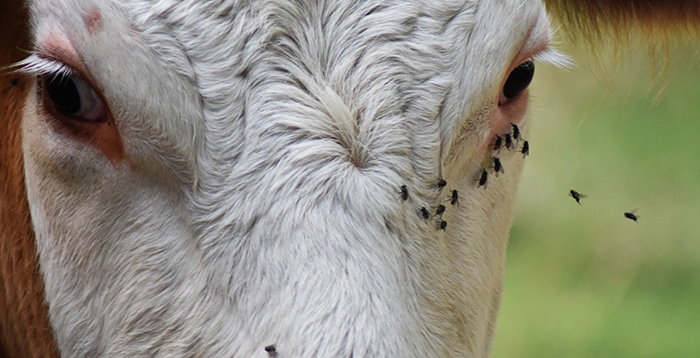It is important fly control takes place before they start appearing on farm in order to keep numbers down and to protect stock. Farm SQP of the Year, Sarah Brooks from Wynnstay, discusses some fly control options.
Getting on top of flies early will help keep the numbers down and prevent what could quite quickly become a massive problem. The two main fly types in cattle you want to try and control include biting flies, which can spread disease such as New Forest eye and summer mastitis, and nuisance flies, which will affect productivity.
Importance of protecting stock
Flies can cause major economic losses in both the dairy and beef herd through reduced feed intake, which impacts on productivity, as well as transmitting diseases.
Studies in cattle have shown that fly worry can cause growth rate losses of up to 0.3kg a day and 0.5l a day milk loss.
As well as using fly control options farmers should also be operating good husbandry to reduce the breeding sites for flies. For example, this includes regular cleaning of bedding and use of disinfectant; having good slurry management and making sure deadstock is collected regularly.
Why products differ
All licensed fly control products use synthetic pyrethroids which kill flies on contact. However, products vary in the active ingredients they use which is why they have different coverage abilities; milk and meat withdrawal times; and also differ in the type of flies and parasites they protect against.
When selecting a product, it is important to consider the coverage you require and whether repeated treatments are feasible and also the cost associated with extra handlings. Aspects such as whether you are treating a pregnant or lactating animal will also come into play.
Whatever product you choose you should always do so in discussion with your health care provider.
The two main fly control options include:
Fly tags
The Flectron fly tag is the only product you can use to ensure season-long control meaning there is no need to retreat. It has guaranteed coverage for four months with no meat or milk withdrawal period.
When selecting a product, it is important to know what fly species it protects against, with Flectron protecting against both nuisance and biting flies.
Benefits:
- Provides season long control so there’s no need to retreat. This reduces the cost of extra handling and also minimises production losses associated with handling.
- Reduces the chance of the fly population building
- Ideal for customers grazing cattle/with common grazing
- No milk or meat withdrawal
- Easy to use
- Gives peace of mind cattle are protected for the entire season.
- Used in all ages of cattle
- Protects against both nuisance and biting flies.
This treatment can be more expensive than pour on products. However, there is no need to retreat as the product provides season-long control and this will therefore save time and labour.
Pour on products
There are a whole range of pour-on products that vary in the types of flies and parasites they protect against, the length of protection, amount needed, and meat and milk withdrawal times.
Most pour-on products protect against both nuisance and biting flies with some also protecting against lice and mange.
Benefits
- Easy to use
- Protects against most flies with some products also protecting against lice and mange
- Not as costly as a fly tag solution although repeated doses may be needed which can add to the cost of additional handling.
Potential Drawbacks
- Repeated doses and handling required for season-long control
- Products are not always applied ahead of the fly season which means the population can build before treatments are given
- Some products have meat and milk withdrawal
- Accurate dosing required for coverage
- Products vary in their coverage time
- Some products require a veterinary risk assessment before use during pregnancy and lactation
Check the product SPC or ask your prescriber for details.
Monitor fly levels
Now in its fifth year, the Parasite Watch service from Zoetis works with 26 farms across the country to provide information on the worm, fly and fluke risk in your area. As part of Parasite Watch, farmers involved in the scheme will be using fly traps to monitor fly populations on the farm.
Fly traps give an indication of the fly challenge. By the time you notice cattle or sheep being troubled by flies, a population explosion is already taking place and it is imperative to take action quickly.
Fly traps are available to buy or farmers can simply make their own).
You can make a fly trap by:
- Take a two-litre plastic bottle and cut off the top third.
- Make some small holes in the base of the bottle to allow rainwater to escape.
- Place the bait, e.g. dog food or an offal-based product, in the bottom of the bottle.
- Invert the top of the bottle into the remainder and use clips/paper clamps to fasten it in place.
- Attach string to the paper clamps and hang the bottle on a fence or gate post.


